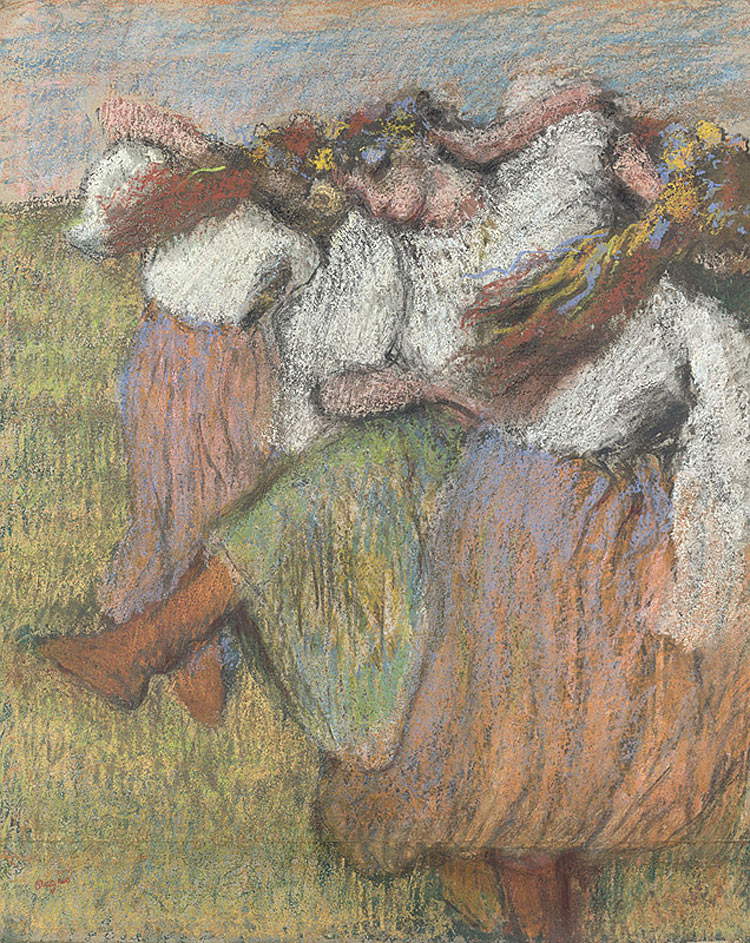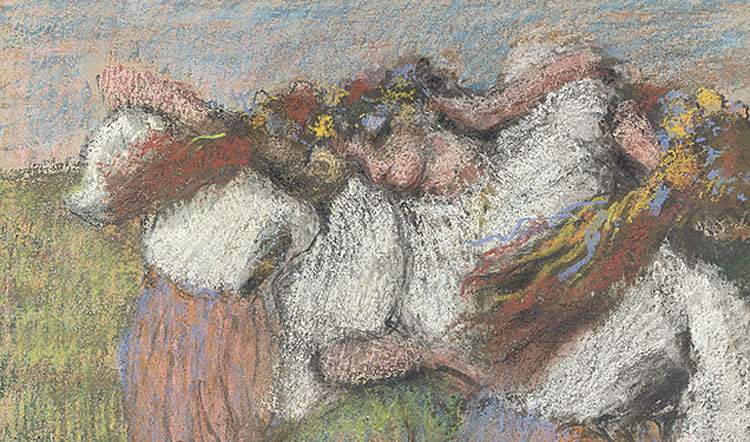The National Gallery in London has decided to change the title of a pastel by Egdar Degas (Paris, 1834 - 1917): the Russian Dancers, a work executed around 1899 that, moreover, is not part of those on public display, becomes Ukrainian Dancers in the wake of the events taking place in Ukraine. The reason for a choice that is sure to cause much discussion was explained to the Guardian by a spokesperson for the museum whose name is not provided: “The title of this painting,” the National Gallery insider explained, “has been discussed for many years and has been dealt with in academic literature; however, there has been an increased focus on it in the last month because of the current situation, so we felt it was an appropriate time to update the title of the painting to better reflect the subject of the painting.”
The issue had been brought to the National Gallery’s attention about a month ago, shortly after the start of the war in Ukraine. The decision was welcomed by Ukrainians working in the art sector in the U.K. “I understand that the term ’Russian art’ has become an easy, useful generic term,” Mariia Kaščenko, founder of the Art Unit association, told the Guardian, “but now it’s really important to get it right. As a Ukrainian person, there were times in the past when I was called Russian, or when Ukrainian heritage was described as Russian.” And there are those who wish for more initiatives like the museum’s: “Every trip to a gallery or museum in London with exhibitions on the art or cinema of the Soviet Union,” points out Olesya Khromeychuk, director of the Institute of Ukrainian Culture in London, “reveals a deliberate or simply lazy misinterpretation of the region as an endless Russia; just as the current president of the Russian Federation would like to see it. Curators have no problem presenting Jewish, Belarusian or Ukrainian art and artists as Russian. On a rare occasion when a Ukrainian is not presented as Russian, he might be presented as ’Ukrainian-born,’ as in the case of filmmaker Oleksandr Dovzhenko in a major exhibition on revolutionary art in London.”

The question on everyone’s mind now is: does this name change make sense? The subject, as the museum explains, has indeed already been addressed in the scientific literature, not least because the Degas pastel preserved in London is not the only one on the subject. Raising the issue of the correct identification of these Degas dancers was, as early as 1987, scholar Lisa R. Bixenstine in her doctoral dissertation at Ohio State University. According to Bixenstine, the women depicted by Degas in his pastels on the theme should not be generically identified as “Russian”: they would actually be Ukrainian women, recognizable because of the clothes that are those typically worn by the aforementioned during summer weddings. Toward the end of the nineteenth century, several Parisian publishers, the scholar Paul Hays Tucker later wrote in the catalog of the Robert Lehman Collection at the Metropolitan in New York published in 2009, “produced photo albums with various traditional costumes of Russia, showing Ukrainian women in the same attire as those drawn by Degas.”
Then there would be the movements, which, explained dance historian and writer Joan Lawson, would be reminiscent of some traditional Ukrainian dances based on animal movements (“jumping, trotting, imitating the movement of the bridled horse and the harnessed horse”). And there would also be political reasons behind Degas’s interest: “many French people,” Tucker further explained, “respected the Ukrainians for preserving their culture and traditions despite centuries of repression, including persecution by the Russians in the late 19th century, when Tsar Alexander II orgoglisly declared the Ukrainian language obsolete. Such tenacity would have impressed Degas, as it suggested the strength and resilience of an ancient civilization. Deags was not much interested in politics, but it is hard to imagine that he would not have appreciated the strength of the Ukrainian people, especially after the warming of diplomatic relations between France and Russia in the last two decades of the century.” A curious coincidence should also be noted, namely the colors of the ribbons worn by the protagonists of the pastel: they are the yellow and blue of the flag of Ukraine. Although the latter was adopted as the Ukrainian flag only in 1918 at the time of the proclamation of the National Republic of Western Ukraine, thus some 20 years after the work was created, yellow and blue were already widely used before (for example by the Black Sea Cossacks).
We do not know where Degas might have seen his dancers, whether Russian or Ukrainian (it should be noted that there is no absolute certainty about the origin of the protagonists of his pastel): he may have seen them in action at the Folies Bergère (where dancers from Eastern Europe were performing in traditional dress in the 1890s), although there is no evidence that he frequented the well-known Parisian venue, or he may have seen the Lumière brothers’ films about Russian dancers, or he may have been inspired by some play he may have seen at the Paris Opera. Scholar Jean Sutherland Boggs, for example, suggested that Degas’s source may have been a performance of Musorgsky’s opera Boris Godunov, performed in Paris in 1909: Sutherland Boggs thus proposed postponing the dating of Degas’s ballerina series, an assumption that has now been superseded in favor of dating it to about 1899, since there is a document from that year that mentions “three pastels depicting women in Russian costumes with flowers in their hair, pearl necklaces, white blouses, skirts in bright colors, and red boots dancing in an imaginary but realistic landscape.” Against the identification of the women as Ukrainian would play the hairstyle: Ukrainian women used to gather their hair in long braids, while Degas depicts them with their hair down, but this may be his own license, a reflection, Tucker explains, of his “personal fascination with women’s hair and its expressive possibilities.” Degas’s lack of accuracy is also evident from the fact that traditional Ukrainian dances assumed that the women moved in unison, which is not the case in his pastels.
Ultimately, are we dealing with Russian or Ukrainian dancers? The National Gallery has no doubts and has already updated the painting’s tab on its website: “they are almost certainly Ukrainian and not Russian,” and would be recognizable because of their traditional clothing and the way they move. Remaining more cautious for now is the Metropolitan Museum in New York, which retains two other pastels in the series and has not changed the titles (which for now remain Russian dancers and Russian dancers): the American institution merely reports the opinion of David Bomford, who in a catalog of a Degas exhibition held at the National Gallery in London in 2004 stated that the dancers in the series “are probably Ukrainian or Slavic,” and that of Lisa Bixenstine who “specifies that the dancers were Ukrainian.” However, explaining the misunderstanding about the title had been, on the Getty Museum website in 2016, art historian Alessandra Nardi: “despite the uniqueness of Ukrainian culture, the dancers were generally called ’Russian dancers’ because most of Ukraine at the time was part of the Russian empire. Moreover, Tsar Alexander II, who ruled from 1851 to 1881, carried out a policy of Russification throughout the empire, forcing Russian communities to abandon their culture and language in favor of Russian ones.” The idea of renaming the work (even though for decades it was identified as Russian Dancers and was also called that by Degas’ contemporaries) is therefore not an act of revisionism but an attempt to make its identification more accurate. It should also be said that despite the debate over the identification of the protagonists, no one had so far changed the title, and certainly this change cannot but be considered a result of the current climate. In any case, given the basis on which the name change is based, it is difficult to consider it simply the result of political correctness. If anything, it is a purely scientific question: favor accuracy or keep the historicized designation? The scientific community will have much to debate.
 |
| London, at the National Gallery Degas's Russian Ballerinas become Ukrainian Ballerinas |
Warning: the translation into English of the original Italian article was created using automatic tools. We undertake to review all articles, but we do not guarantee the total absence of inaccuracies in the translation due to the program. You can find the original by clicking on the ITA button. If you find any mistake,please contact us.